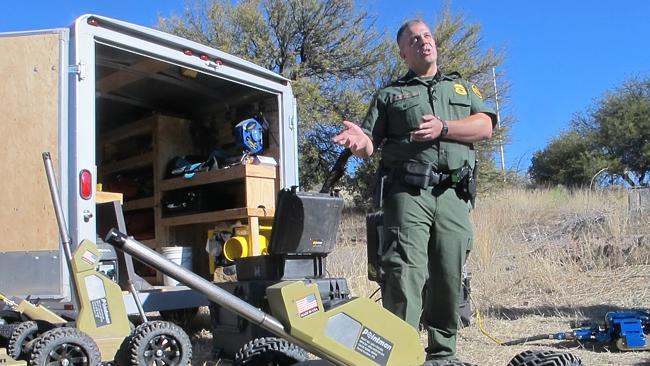The incredible tunnel network along the US-Mexico border
THE US-Mexico border is littered with an incredible network of tunnels used to transport drugs, guns and people. Here's how the US border patrol is fighting the war.

Work
Don't miss out on the headlines from Work. Followed categories will be added to My News.
AS BORDER security has tightened, drug cartels have turned to tunnelling beneath the ground to avoid detection.
Nearly 170 tunnels have been found nationwide since 1990, most along the Arizona and California border with Mexico. The job of searching these networks can be dangerous, so the U.S. Border Patrol is unveiling its latest technology in the underground war - a wireless, camera-equipped robot that can do the job in a fraction of the time.
How are they built?
Tunnel construction ranges from extremely rudimentary, a small burrow dug by hand sometimes only large enough for a person to crawl through, to very sophisticated, including lights, supports to hold up the ceiling and ventilation. They can range from just a few feet stretching from one side of the border to the other, to up to a quarter mile (0.8 kilometres) long.
Some tunnels merely go from one side of the border to the other with the contraband being offloaded in a field or on public land, while others exit into warehouses or homes along the border.

Miners and other labourers hired by cartels use hoes, jackhammers, shovels and picks to gouge out soil and load the dirt into buckets that are brought back out of the tunnel's starting point in Mexico. Their tools are old-fashioned and can be bought at home improvement stores. Miners, for instance, must use compasses because GPS devices don't work underground.
Smugglers have dug dozens of crude tunnels in Nogales, Arizona, that begin in Mexico and tie into the Arizona city's storm drainage system.
For sophisticated tunnels, such as those found near San Diego, cartels will hire engineers and miners to build the tunnels. A cartel will have a financier or a cell that reports to the cartel bosses and runs the construction.
US border officials estimate that the more sophisticated tunnels probably cost between $2 million to $3 million to build.
How are the tunnels used?
Smuggling groups use tunnels to move drugs, guns and people who want to sneak across the US border, though traffickers are sometimes selective about what they will move through their tunnels.
Experts say sophisticated tunnels are used for mostly drug and gun smuggling, though people who don't want to risk travelling above ground will occasionally be sneaked through those tunnels.
Cocaine and methamphetamine are brought in through the tunnels, but marijuana - which is big and bulky and therefore difficult to move - is the most prevalent drug transported through the tunnels.

Authorities found a 600-yard (550m) tunnel in southern California during November 2011 that resulted in seizures of 32 tons of marijuana on both sides of the border, with 26 tons found on the US side, accounting for one of the largest marijuana busts in US history. That tunnel was equipped with electric railcars, lighting and ventilation while wooden planks lined the floor.
Immigrant smugglers use "gofer hole" tunnels made up of huge PVC pipes that are buried underground and span the border, providing enough space through which a person can barely squeeze.
The storm-drain tunnels in places like Nogales are used for both immigrant and drug smuggling.
How are tunnels discovered?
The majority of tunnels are found by human intelligence, either by Mexican or US authorities patrolling the border and noticing the ground has been disturbed, or through informants who tip authorities to their presence.
How are they explored and investigated once found?
So-called tunnel robots have been in use by Border Patrol for several years. They can safely navigate through corrugated pipes, tunnels, and drainage systems while an agent controls the device from the surface, seeing what the robot sees on a handheld screen. The robots are used, in part, as a safety measure to keep agents out of harm's way as many tunnels can be poorly built and possibly collapse and lack proper ventilation.
They also can navigate an underground labyrinth in a fraction of the time it would take an agent to explore the tunnel. Some of the newer robots, which weigh about 12 pounds (5.5 kilograms) and can navigate through passageways that are only several feet wide, are being deployed this year across southern Arizona and California.
###

